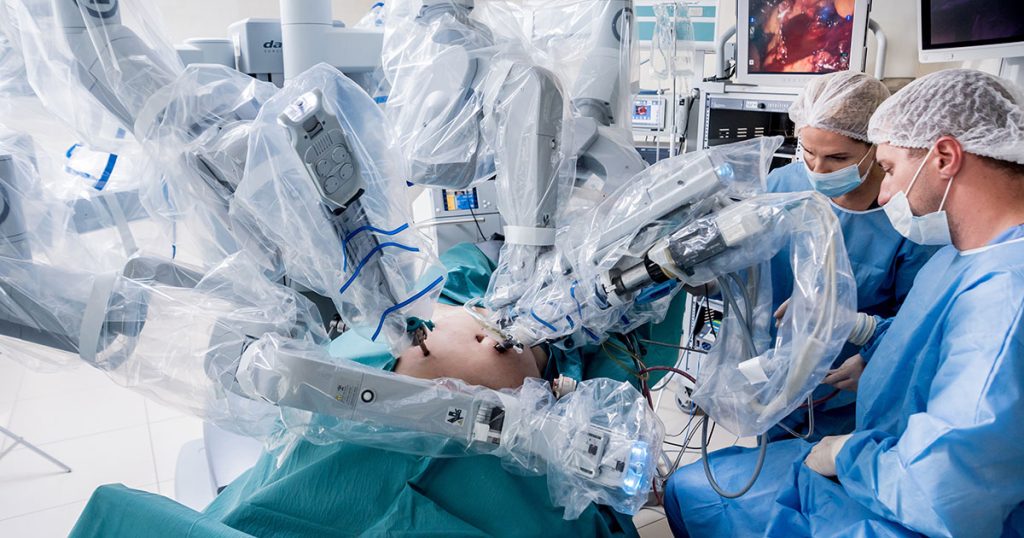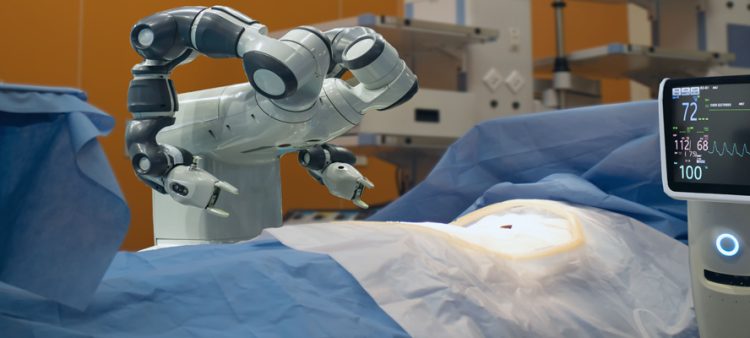1. Introduction
In the past few decades, medical robots have evolved from experimental technologies into mainstream tools that are now integral to modern healthcare systems worldwide. These robots have revolutionized multiple aspects of patient care, including surgery, rehabilitation, and daily care services for the elderly and disabled. The role of medical robots is diverse, spanning across various specialized fields, including robotic-assisted surgery, robotic prosthetics, rehabilitation robotics, and even caregiving robots for elderly patients.
The continued integration of artificial intelligence (AI), machine learning, computer vision, and advanced sensors into robotic systems is driving improvements in precision, patient outcomes, and operational efficiency. In this paper, we explore how medical robots are reshaping three critical aspects of healthcare: surgical procedures, rehabilitation, and patient care. Additionally, we examine the challenges that still hinder the widespread adoption of these technologies and discuss their future potential.
2. Robotic Surgery: Revolutionizing the Operating Room
Robotic surgery, or robot-assisted surgery, refers to surgeries performed using robotic systems that allow surgeons to perform complex procedures with enhanced precision, flexibility, and control. This technology has become increasingly important in reducing recovery times, minimizing scarring, and improving surgical outcomes.
2.1 Key Robotic Surgical Systems
- da Vinci Surgical System: The da Vinci system by Intuitive Surgical is one of the most widely used robotic surgical platforms in the world. It enables surgeons to perform minimally invasive surgeries with robotic arms that provide high-definition 3D visualization, enhanced dexterity, and precise movements. The system allows surgeons to control the robotic arms via a console, using hand and foot controls.
- Mako Robotic-Arm Assisted Surgery: The Mako system, used in orthopedic procedures such as knee and hip replacement, offers a high degree of accuracy in placing implants. The system uses preoperative CT scans to create a personalized 3D model of the patient’s anatomy, allowing for precise planning and execution during surgery.
- Robot-Assisted Laparoscopy (RAS): Robotic laparoscopy is frequently employed in minimally invasive procedures, including urology, gynecology, and gastrointestinal surgery. It allows for smaller incisions, which leads to less postoperative pain, shorter hospital stays, and faster recovery times.
2.2 Advantages of Robotic Surgery
- Minimally Invasive Procedures: Robotic surgery enables smaller incisions, which reduce the risk of infection, minimize blood loss, and improve recovery times. For example, in prostatectomy (removal of the prostate), robotic surgery offers the benefit of improved accuracy in nerve-sparing procedures, potentially reducing the risk of side effects such as incontinence and erectile dysfunction.
- Precision and Control: Surgeons can perform delicate operations with precision beyond human capabilities. Robots can move in ways that are difficult or impossible for the human hand, providing a high level of control and reducing the risk of human error.
- Enhanced Visualization: Robotic surgical systems provide high-definition 3D visualization, which allows surgeons to view the surgical site in great detail. This feature is especially beneficial in complex surgeries where clear visualization of tissues, blood vessels, and nerves is critical.
- Reduced Recovery Time: Patients who undergo robotic-assisted surgeries typically experience less pain, fewer complications, and a quicker recovery time compared to traditional open surgery. In some cases, these surgeries are outpatient procedures, allowing patients to return home the same day.
2.3 Challenges in Robotic Surgery
- Cost: The implementation of robotic surgery systems requires a significant upfront investment, and ongoing maintenance costs can be high. Additionally, there is a learning curve for surgeons who must undergo specialized training to operate robotic systems effectively.
- Technological Limitations: While robotic systems provide enhanced precision, they still have limitations. For example, robots cannot yet replicate the intuition and adaptability of human surgeons in certain dynamic situations.
- Integration with Existing Systems: Integrating robotic surgical systems with a hospital’s existing infrastructure can be challenging. Hospitals must ensure compatibility with other medical equipment, electronic health records (EHR), and procedural workflows.
3. Rehabilitation Robots: Facilitating Recovery
Rehabilitation robots are revolutionizing how patients recover from injuries, strokes, or surgeries. These robots provide assistance in physical therapy, helping patients regain lost motor function, improve mobility, and enhance overall quality of life.
3.1 Types of Rehabilitation Robots
- Exoskeletons: Robotic exoskeletons are wearable devices designed to support and augment a person’s movements. These robots assist individuals with spinal cord injuries, stroke patients, or those suffering from neurological conditions by helping them regain the ability to walk. Companies such as ReWalk Robotics and Ekso Bionics have developed exoskeletons that enable users to stand and walk, promoting rehabilitation and improving both physical and psychological well-being.
- Robotic Therapy Devices: Devices like Lokomat use robotic arms and legs to help patients with limited mobility complete physical therapy exercises. The Lokomat provides consistent, controlled movement, aiding in the recovery of walking abilities and improving muscle strength and joint flexibility.
- Robotic Hands and Prosthetics: Prosthetic arms and hands are becoming increasingly advanced, with robotic prosthetics offering more natural movements. These devices use sensors to detect muscle signals and respond accordingly, providing a level of dexterity and flexibility that traditional prosthetics cannot achieve.
3.2 Benefits of Rehabilitation Robots
- Precision and Consistency: Rehabilitation robots can deliver therapy with precise, controlled movements, ensuring that patients receive consistent treatment. For example, exoskeletons can help patients perform repetitive movements, which is essential for neuroplasticity (the brain’s ability to adapt to injury and recover).
- Personalized Rehabilitation Plans: Many rehabilitation robots can be programmed to adjust based on the patient’s progress, offering personalized treatment. By continuously adjusting therapy intensity, frequency, and duration, robots can optimize the recovery process.
- Faster Recovery Times: Robotic-assisted rehabilitation can speed up recovery by ensuring that patients are performing therapeutic exercises accurately and consistently. Patients can also participate in therapy more frequently and intensively without requiring a therapist to be present for every session.
3.3 Challenges in Rehabilitation Robotics
- Cost and Accessibility: While the benefits of rehabilitation robots are clear, the cost of these systems can be prohibitively high, especially in countries with limited healthcare resources. Additionally, accessibility is an issue, as not all healthcare providers have access to advanced robotic rehabilitation technologies.
- Patient Comfort and Adaptation: Not all patients can adapt to the mechanical devices used in robotic rehabilitation. Some may experience discomfort or psychological resistance to using robots in their recovery process.
- Technological Complexity: Robotic rehabilitation systems often require specialized training for both clinicians and patients, which can slow down the adoption of these technologies.

4. Robots in Patient Care: Enhancing Everyday Healthcare
In addition to their role in surgery and rehabilitation, robots are increasingly being integrated into patient care, particularly in assisting with daily tasks for elderly individuals, people with disabilities, and patients in long-term care settings.
4.1 Assistive Robots for Elderly and Disabled Patients
- Companion Robots: Robots like PARO, a therapeutic robotic seal, have been developed to provide companionship and emotional support to elderly patients, particularly those with dementia or Alzheimer’s disease. These robots can engage in interactions that help reduce feelings of loneliness and anxiety in patients.
- Robotic Care Assistants: Robots such as Pepper and Buddy are designed to assist patients with daily activities, including reminding them to take their medication, offering communication with family members, and even performing basic cleaning tasks.
- Robots for Mobility Assistance: Robots like GeriBot and Robotic Wheelchairs assist elderly and disabled individuals with mobility, helping them navigate their environment independently. These robots are designed to provide support in activities such as moving between rooms, shopping, and transportation.
4.2 Benefits of Robotic Patient Care
- Improved Quality of Life: Assistive robots enhance the quality of life for elderly and disabled individuals by promoting independence, reducing the burden on caregivers, and ensuring that patients are more comfortable in their daily routines.
- 24/7 Availability: Unlike human caregivers, robots can provide continuous care, ensuring that patients receive consistent monitoring and assistance at any time of day or night.
- Support for Healthcare Workers: Robots can relieve healthcare workers from physically demanding tasks such as lifting, transferring patients, and providing companionship. This enables healthcare staff to focus on more specialized care, improving the overall efficiency of healthcare systems.
4.3 Challenges in Patient Care Robotics
- Social Acceptance: Despite their benefits, many patients may be reluctant to accept robots as a substitute for human interaction. In some cultures, there is resistance to the idea of robots assisting with caregiving roles, particularly for elderly individuals who may prefer human companionship.
- Technology Reliability: The reliability of assistive robots remains a concern. Robots must be able to function autonomously in real-world environments, where unexpected challenges such as obstacles or system malfunctions can arise.
- Privacy and Data Security: Many patient care robots collect sensitive data, including health metrics, behavior patterns, and interactions with patients. Ensuring that this data is securely handled is essential to protecting patient privacy and confidentiality.
5. Future of Medical Robots: A Vision for Healthcare
The future of medical robots is exciting and holds tremendous potential. With advancements in AI, machine learning, and robotics, future medical robots will become even more intelligent, capable of performing increasingly complex tasks. Emerging trends include:
- AI-Driven Personalization: AI will enable robots to provide even more personalized care, tailoring treatments and rehabilitation plans to the individual needs of each patient.
- Miniaturization and Portability: Future robots will likely become smaller, more portable, and easier to deploy in various healthcare settings, from hospitals to home care environments.
- Integration with Telemedicine: Robots could also become integral components of telemedicine platforms, enabling remote surgeries, rehabilitation, and patient monitoring.
6. Conclusion
Medical robots are transforming healthcare by providing innovative solutions for surgery, rehabilitation, and patient care. While challenges remain, particularly in terms of cost, accessibility, and patient acceptance, the benefits of medical robots are undeniable. As technology continues to evolve, we can expect even greater advancements that will improve the precision, efficiency, and accessibility of healthcare for all. The future of medical robotics is not just about enhancing the abilities of healthcare providers, but also about improving patient outcomes, reducing costs, and making healthcare more accessible to people worldwide.











































